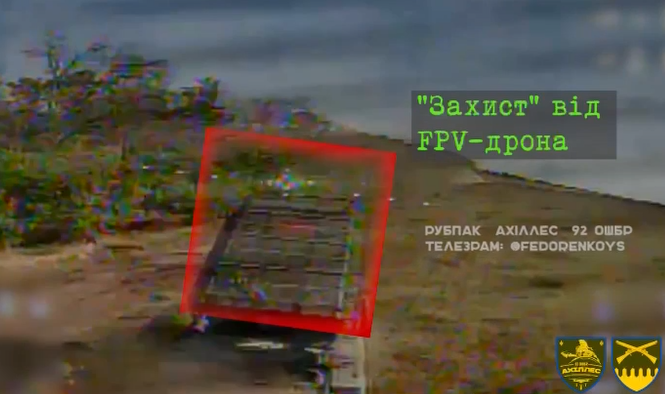The Ukrainian Defense Forces have effectively destroyed a formidable Russian TOS-1A Solntsepyok thermobaric rocket launcher using an explosive First-Person View (FPV) drone.
Bayraktar TB2 Drone Makes A ‘Grand Re-Entry’; Destroys Russian Patrol Boat Carrying Troops To Ukrainian Coast
On September 3, Achilles Company shared a video with a caption stating that the operator from the 92nd “Ivan Sirko” Mechanized Brigade, affiliated with Achilles Company’s unmanned attack aircraft systems, successfully struck the intended target.
The drone struck the top section of the launcher, indicating that the projectile likely had a High-Explosive Anti-Tank (HEAT) warhead. Following the collision, a subsequent detonation occurred involving the ammunition of the flamethrower system.
The UAV hovering above the site recorded when the ammunition inside the launcher began to ignite and explode due to the strike.
According to the reports, the Solntsepyok heavy flamethrower system was fully loaded, housing its complete arsenal of 24 thermobaric rockets. The Ukrainian armed forces also alleged that all three crew members were eliminated in this attack.
Raihorodka, Luhansk Oblast, Ukrainian forces from the 92nd Mechanized Brigade hit a Russian TOS-1A with an FPV loitering munition, causing a catastrophic cookoff of the MRL. pic.twitter.com/pVrRnBCIWO
— OSINTtechnical (@Osinttechnical) September 2, 2023
Based on the visual evidence provided in the video, it becomes apparent that the Solntsepyok launcher had been outfitted with an anti-drone cage designed to protect against incoming ammunition drops, as well as FPV drones.
The EurAsian Times had earlier reported that Russia had installed “cope cages” atop its TOS-1 Solntsepyok flamethrowers, aiming to reduce the vulnerability of these vehicles to counterattacks.
Referred to by various names such as slat armor, bar armor, cage armor, and stand-off armor, cope cages represent a protective strategy employed in heavy military vehicles to mitigate the damage inflicted by high-explosive anti-tank (HEAT) weaponry.
The first cage-like structures on Russian T-80 tanks were noted in November 2021. Later, a TikTok video gained widespread attention, depicting an aging Soviet-era T-80 tank maneuvering through muddy terrain with its turret shielded by an unconventional metal slat covering.

Shortly after this development, Ukrainian forces commenced trials of Javelin missiles on stationary targets fitted with protective cages.
The results proved unfavorable for Russian forces in the subsequent months, as Ukrainian anti-tank guided missiles (ATGMs) effectively destroyed several Russian tanks despite protective cages.
The new incident also further demonstrates these cage structures’ limited effectiveness.
TOS-1A System
According to the Oryx open-source intelligence website, Russia lost the eighth TOS-1A flamethrower system since the commencement of its special military operation in Ukraine in February 2022.
Among these losses, four have been destroyed, three were captured, and one sustained damage.
The loss of the system is significant because a single Solntsepek rocket system is estimated to exceed US$6.5 million in total cost, covering servicing, training, and ammunition expenses. In contrast, an FPV drone is much more affordable, typically from US$341 to US$462.
The capability of launching between 24 and 30 thermobaric rockets has prompted Russia’s Defense Ministry to classify the Solntsepek as a “heavy flamethrower” system.
In March 2022, the British Defense Ministry stated that the TOS-1A’s thermobaric rockets generate both “incendiary and blast effects” due to the oxygen needed for the explosion.
On the other hand, Russian state media has highlighted the Solntsepek’s versatility, noting its capability to engage targets at close range and reach distances of up to 5.6 miles.
Earlier this year, the Russian Defense Ministry reported using Solntsepek systems in Ukraine, describing how Russian forces utilized 220mm shells launched by these rocket systems to target Ukrainian positions effectively. This destroyed shelters, observation posts, ammunition depots, and artillery positions.
Experts have contended that Solntsepek systems can produce an exceptionally potent shock wave capable of damaging buildings significantly.
Therefore, considering the highly destructive nature of these weapons, which utilize rockets with thermobaric or fuel-air explosive warheads, causing high-temperature explosions by drawing in surrounding oxygen, it’s entirely understandable why Ukraine would want to prioritize targeting and neutralizing them.
On their part, Russia has taken measures to address this threat by installing metal grids on top of vehicles to intercept munitions before they can cause catastrophic damage.
However, the effectiveness of these protective cages remains in doubt, even though some Russian tanks have managed to survive attacks with the cages in place.
Nevertheless, if a complete set of rockets were to detonate within a TOS-1 launcher, it would pose a severe danger to anyone in the vicinity, as exemplified in the latest attack.
- Contact the author at ashishmichel(at)gmail.com
- Follow EurAsian Times on Google News